Founded in 1938 and published semiannually by Sophia University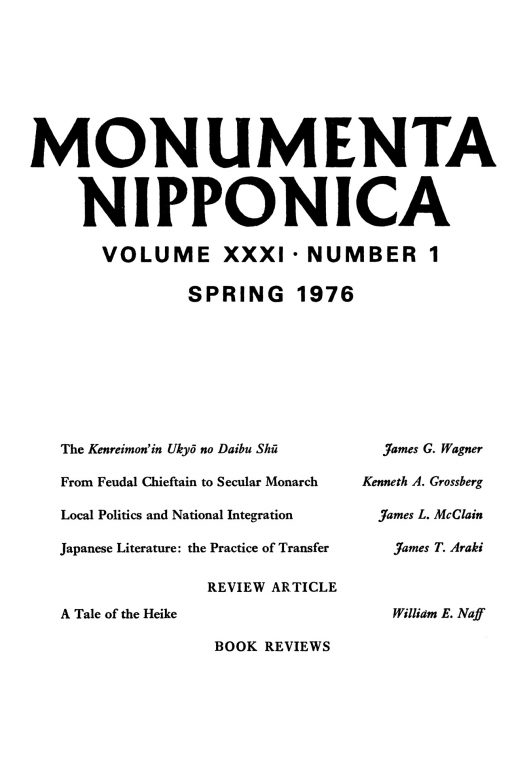 MN 31:1 (1976) 87–95A Tale of the HeikeWilliam E. Naff
MN 31:1 (1976) 87–95A Tale of the HeikeWilliam E. Naff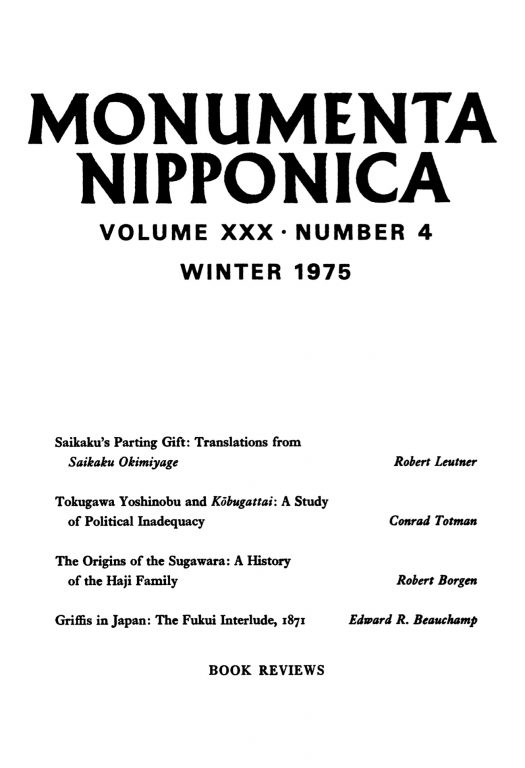 MN 30:4 (1975) 357–91Saikaku’s Parting Gift: Translations from Saikaku OkimiyageRobert W. Leutner
MN 30:4 (1975) 357–91Saikaku’s Parting Gift: Translations from Saikaku OkimiyageRobert W. Leutner MN 30:4 (1975) 393–403Tokugawa Yoshinobu and Kōbugattai: A Study of Political InadequacyConrad Totman
MN 30:4 (1975) 393–403Tokugawa Yoshinobu and Kōbugattai: A Study of Political InadequacyConrad Totman MN 30:4 (1975) 405–22The Origins of the Sugawara: A History of the Haji FamilyRobert Borgen
MN 30:4 (1975) 405–22The Origins of the Sugawara: A History of the Haji FamilyRobert Borgen MN 30:4 (1975) 423–52Griffis in Japan: The Fukui Interlude, 1871Edward R. Beauchamp
MN 30:4 (1975) 423–52Griffis in Japan: The Fukui Interlude, 1871Edward R. Beauchamp MN 30:4 (1975) 478–84Survey of JournalsMichael Cooper
MN 30:4 (1975) 478–84Survey of JournalsMichael Cooper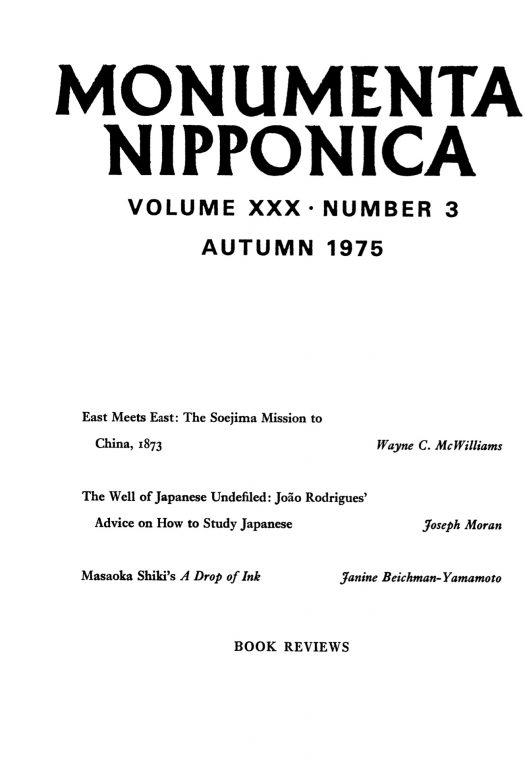 MN 30:3 (1975) 237–75East Meets East: The Soejima Mission to China, 1873Wayne C. McWilliams
MN 30:3 (1975) 237–75East Meets East: The Soejima Mission to China, 1873Wayne C. McWilliams MN 30:3 (1975) 277–89The Well of Japanese Undefiled: João Rodrigues’ Advice on How to Study JapaneseJoseph F. Moran
MN 30:3 (1975) 277–89The Well of Japanese Undefiled: João Rodrigues’ Advice on How to Study JapaneseJoseph F. Moran MN 30:3 (1975) 291–315Masaoka Shiki’s A Drop of InkJanine Beichman-Yamamoto
MN 30:3 (1975) 291–315Masaoka Shiki’s A Drop of InkJanine Beichman-Yamamoto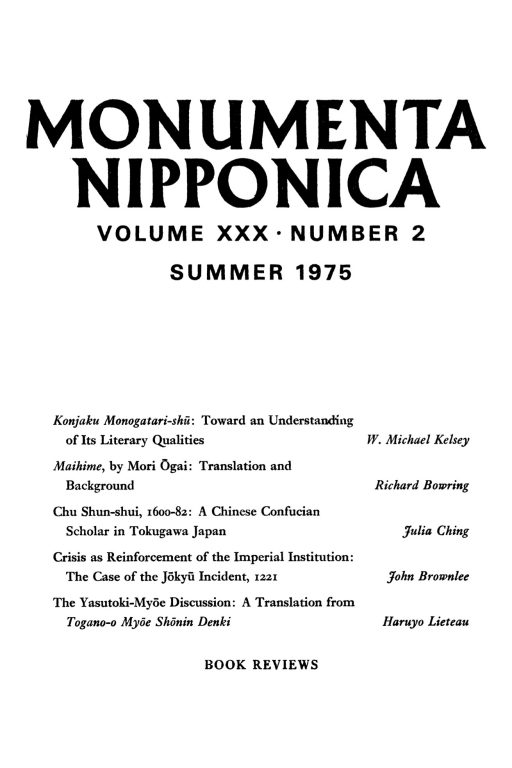 MN 30:2 (1975) 121–50Konjaku Monogatari-shū: Toward an Understanding of Its Literary QualitiesW. Michael Kelsey
MN 30:2 (1975) 121–50Konjaku Monogatari-shū: Toward an Understanding of Its Literary QualitiesW. Michael Kelsey MN 30:2 (1975) 177–91Chu Shun-Shui, 1600–82: A Chinese Confucian Scholar in Tokugawa JapanJulia Ching
MN 30:2 (1975) 177–91Chu Shun-Shui, 1600–82: A Chinese Confucian Scholar in Tokugawa JapanJulia Ching MN 30:2 (1975) 193–201Crisis as Reinforcement of the Imperial Institution: The Case of the Jōkyū Incident, 1221John S. Brownlee
MN 30:2 (1975) 193–201Crisis as Reinforcement of the Imperial Institution: The Case of the Jōkyū Incident, 1221John S. Brownlee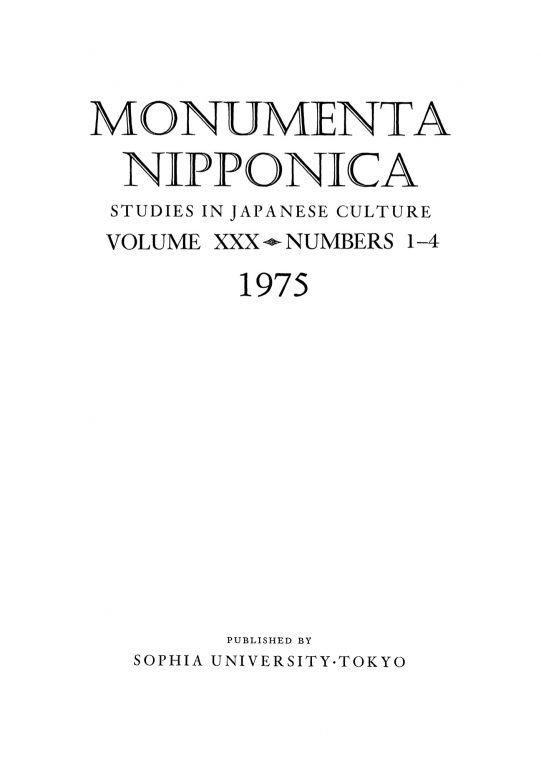 MN 30:1 (1975) 1–18A Japanese Burlesque: Nise MonogatariJack Rucinski
MN 30:1 (1975) 1–18A Japanese Burlesque: Nise MonogatariJack Rucinski MN 30:1 (1975) 19–35Nichiren and Nationalism: The Religious Patriotism of Tanaka ChigakuEdwin B. Lee
MN 30:1 (1975) 19–35Nichiren and Nationalism: The Religious Patriotism of Tanaka ChigakuEdwin B. Lee MN 30:1 (1975) 37–68Soga Monogatari, Shintōshū and the Taketori Legend: The Nature and Significance of Parallels between the manabon Soga Monogatari and Shintōshū, with Particular Reference to a Parallel Variant of the Taketori LegendD. E. Mills
MN 30:1 (1975) 37–68Soga Monogatari, Shintōshū and the Taketori Legend: The Nature and Significance of Parallels between the manabon Soga Monogatari and Shintōshū, with Particular Reference to a Parallel Variant of the Taketori LegendD. E. Mills MN 30:1 (1975) 69–85Japan’s First Modern Theater: The Tsukiji Shōgekijō and Its Company, 1924–26Brian Powell
MN 30:1 (1975) 69–85Japan’s First Modern Theater: The Tsukiji Shōgekijō and Its Company, 1924–26Brian Powell MN 30:1 (1975) 87–93A Note on the Hyakumantō DhāranīBrian Hickman
MN 30:1 (1975) 87–93A Note on the Hyakumantō DhāranīBrian Hickman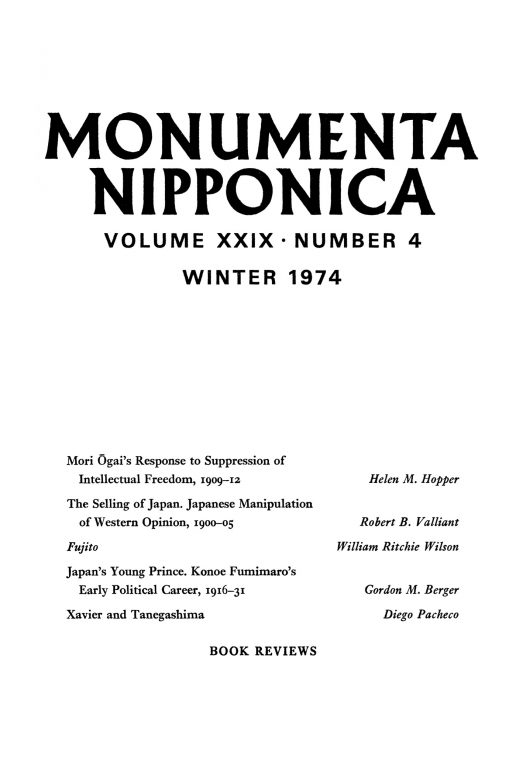 MN 29:4 (1974) 381–413Mori Ōgai’s Response to Suppression of Intellectual Freedom, 1909–12Helen M. Hopper
MN 29:4 (1974) 381–413Mori Ōgai’s Response to Suppression of Intellectual Freedom, 1909–12Helen M. Hopper MN 29:4 (1974) 415–38The Selling of Japan: Japanese Manipulation of Western Opinion, 1900–1905Robert B. Valliant
MN 29:4 (1974) 415–38The Selling of Japan: Japanese Manipulation of Western Opinion, 1900–1905Robert B. Valliant MN 29:4 (1974) 451–75Japan’s Young Prince: Konoe Fumimaro’s Early Political Career, 1916–1931Gordon Mark Berger
MN 29:4 (1974) 451–75Japan’s Young Prince: Konoe Fumimaro’s Early Political Career, 1916–1931Gordon Mark Berger MN 29:4 (1974) 477–80Xavier and TanegashimaDiego Pacheco
MN 29:4 (1974) 477–80Xavier and TanegashimaDiego Pacheco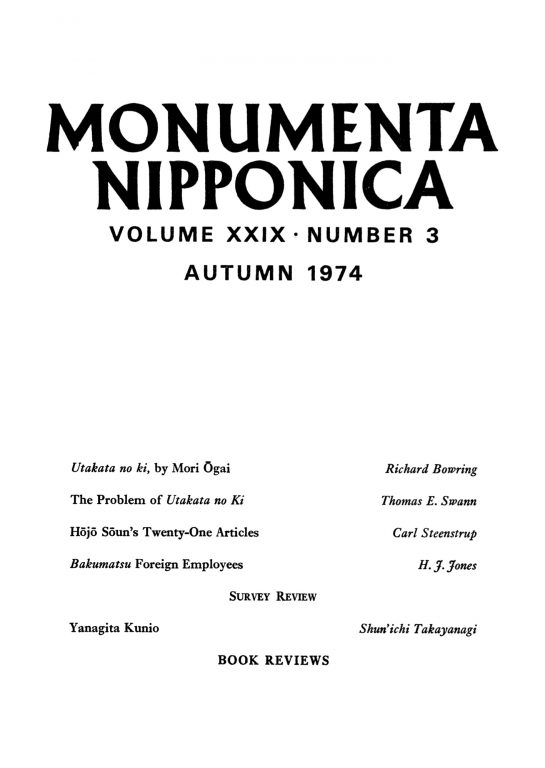 MN 29:3 (1974) 263–81The Problem of Utakata no KiThomas E. Swann
MN 29:3 (1974) 263–81The Problem of Utakata no KiThomas E. Swann MN 29:3 (1974) 283–303Hōjō Sōun’s Twenty-One Articles: The Code of Conduct of the Odawara HōjōCarl Steenstrup
MN 29:3 (1974) 283–303Hōjō Sōun’s Twenty-One Articles: The Code of Conduct of the Odawara HōjōCarl Steenstrup MN 29:3 (1974) 305–27Bakumatsu Foreign EmployeesH. J. Jones
MN 29:3 (1974) 305–27Bakumatsu Foreign EmployeesH. J. Jones MN 29:3 (1974) 329–35Yanagita KunioShun’ichi H. Takayanagi
MN 29:3 (1974) 329–35Yanagita KunioShun’ichi H. Takayanagi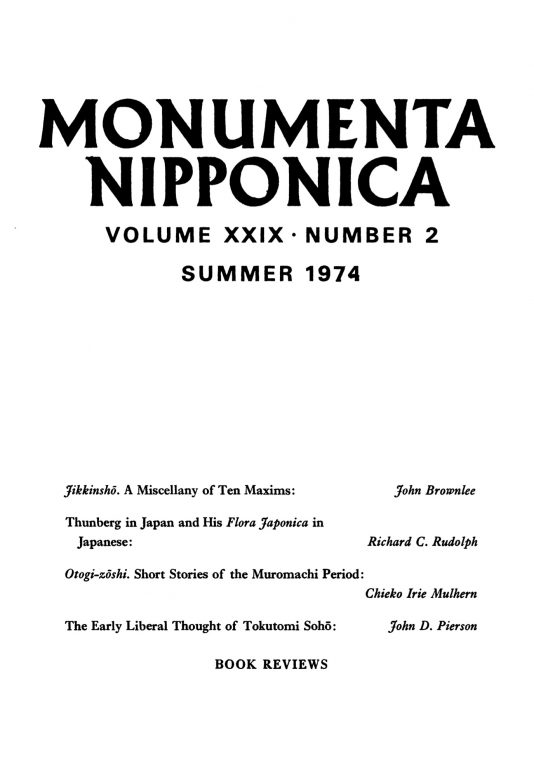 MN 29:2 (1974) 121–61Jikkinshō: A Miscellany of Ten MaximsJohn S. Brownlee
MN 29:2 (1974) 121–61Jikkinshō: A Miscellany of Ten MaximsJohn S. Brownlee MN 29:2 (1974) 163–79Thunberg in Japan and His Flora Japonica in JapaneseRichard C. Rudolph
MN 29:2 (1974) 163–79Thunberg in Japan and His Flora Japonica in JapaneseRichard C. Rudolph MN 29:2 (1974) 181–98Otogi-zōshi: Short Stories of the Muromachi PeriodChieko Irie Mulhern
MN 29:2 (1974) 181–98Otogi-zōshi: Short Stories of the Muromachi PeriodChieko Irie Mulhern MN 29:2 (1974) 199–224The Early Liberal Thought of Tokutomi Sohō: Some Problems of Western Social Theory in Meiji JapanJohn D. Pierson
MN 29:2 (1974) 199–224The Early Liberal Thought of Tokutomi Sohō: Some Problems of Western Social Theory in Meiji JapanJohn D. Pierson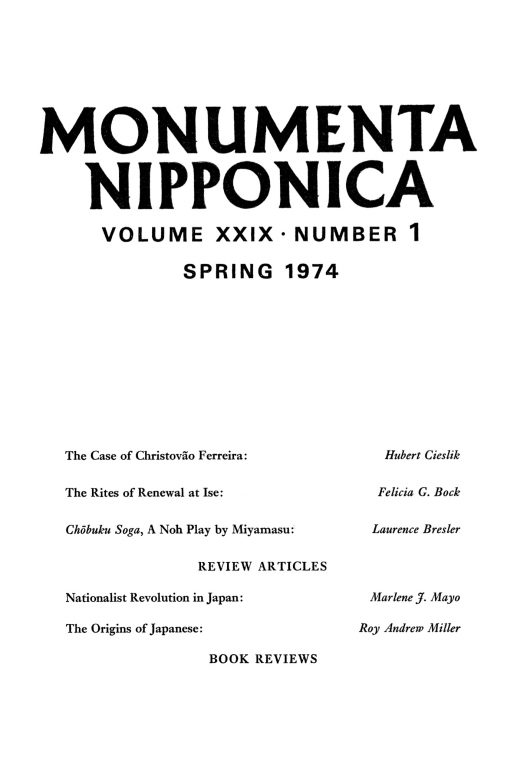 MN 29:1 (1974) 1–54The Case of Christovão FerreiraHubert Cieslik
MN 29:1 (1974) 1–54The Case of Christovão FerreiraHubert Cieslik MN 29:1 (1974) 55–68The Rites of Renewal at IseFelicia Gressitt Bock
MN 29:1 (1974) 55–68The Rites of Renewal at IseFelicia Gressitt Bock MN 29:1 (1974) 83–91Nationalist Revolution in JapanMarlene J. Mayo
MN 29:1 (1974) 83–91Nationalist Revolution in JapanMarlene J. Mayo MN 29:1 (1974) 93–102The Origins of JapaneseRoy Andrew Miller
MN 29:1 (1974) 93–102The Origins of JapaneseRoy Andrew Miller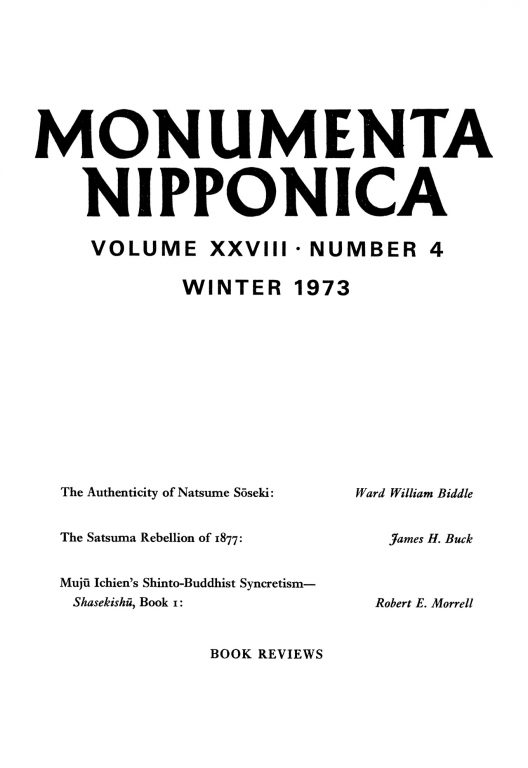 MN 28:4 (1973) 391–426The Authenticity of Natsume SōsekiWard William Biddle
MN 28:4 (1973) 391–426The Authenticity of Natsume SōsekiWard William Biddle MN 28:4 (1973) 427–46The Satsuma Rebellion of 1877: From Kagoshima Through the Siege of Kumamoto CastleJames H. Buck
MN 28:4 (1973) 427–46The Satsuma Rebellion of 1877: From Kagoshima Through the Siege of Kumamoto CastleJames H. Buck MN 28:4 (1973) 447–88Mujū Ichien’s Shinto-Buddhist Syncretism: Shasekishū, Book 1Robert E. Morrell
MN 28:4 (1973) 447–88Mujū Ichien’s Shinto-Buddhist Syncretism: Shasekishū, Book 1Robert E. Morrell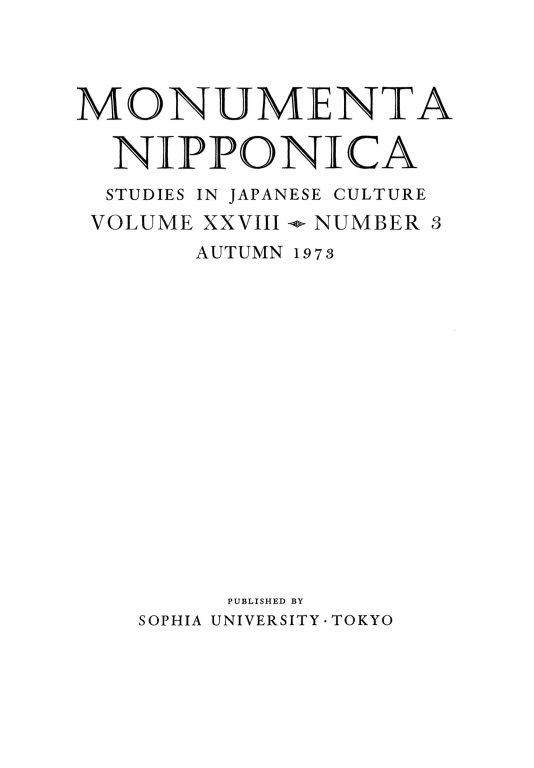 MN 28:3 (1973) 261–93Preliminary Notes on Masakadoki and the Taira no Masakado StoryGiuliana Stramigioli
MN 28:3 (1973) 261–93Preliminary Notes on Masakadoki and the Taira no Masakado StoryGiuliana Stramigioli MN 28:3 (1973) 295–316The Imagawa Letter: A Muromachi Warrior’s Code of Conduct Which Became a Tokugawa SchoolbookCarl Steenstrup
MN 28:3 (1973) 295–316The Imagawa Letter: A Muromachi Warrior’s Code of Conduct Which Became a Tokugawa SchoolbookCarl Steenstrup MN 28:3 (1973) 317–45Japan’s Peace Preservation Law of 1925: Its Origins and SignificanceRichard H. Mitchell
MN 28:3 (1973) 317–45Japan’s Peace Preservation Law of 1925: Its Origins and SignificanceRichard H. Mitchell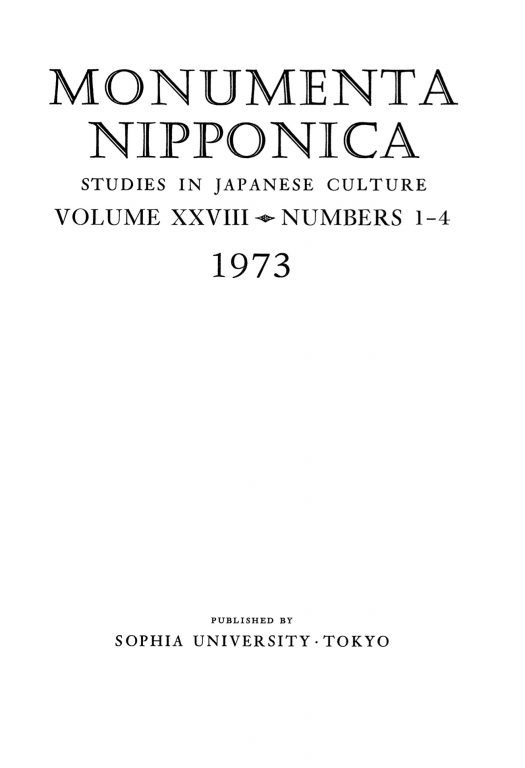 MN 28:2 (1973) 139–49Pathos and Farce: Zatō Plays of the Kyōgen RepertoireJacqueline Golay
MN 28:2 (1973) 139–49Pathos and Farce: Zatō Plays of the Kyōgen RepertoireJacqueline Golay MN 28:2 (1973) 151–75Nishi Amane and the Reception of Western Law in JapanRichard H. Minear
MN 28:2 (1973) 151–75Nishi Amane and the Reception of Western Law in JapanRichard H. Minear MN 28:2 (1973) 177–233The Way of the Bow and Arrow: The Japanese Warrior in Konjaku MonogatariWilliam Ritchie Wilson
MN 28:2 (1973) 177–233The Way of the Bow and Arrow: The Japanese Warrior in Konjaku MonogatariWilliam Ritchie Wilson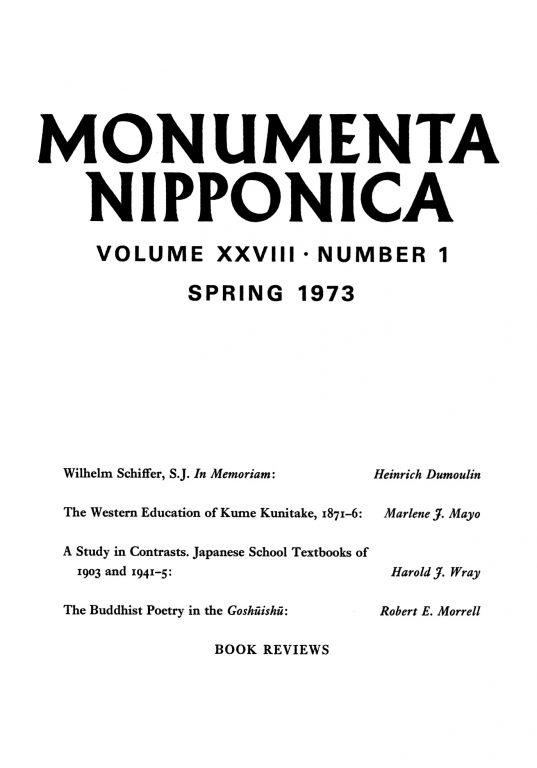 MN 28:1 (1973) 3–67The Western Education of Kume Kunitake, 1871–6Marlene J. Mayo
MN 28:1 (1973) 3–67The Western Education of Kume Kunitake, 1871–6Marlene J. Mayo MN 28:1 (1973) 69–86A Study in Contrasts: Japanese School Textbooks of 1903 and 1941–5Harry (Harold J.) Wray
MN 28:1 (1973) 69–86A Study in Contrasts: Japanese School Textbooks of 1903 and 1941–5Harry (Harold J.) Wray MN 28:1 (1973) 87–100The Buddhist Poetry in the GoshūishūRobert E. Morrell
MN 28:1 (1973) 87–100The Buddhist Poetry in the GoshūishūRobert E. Morrell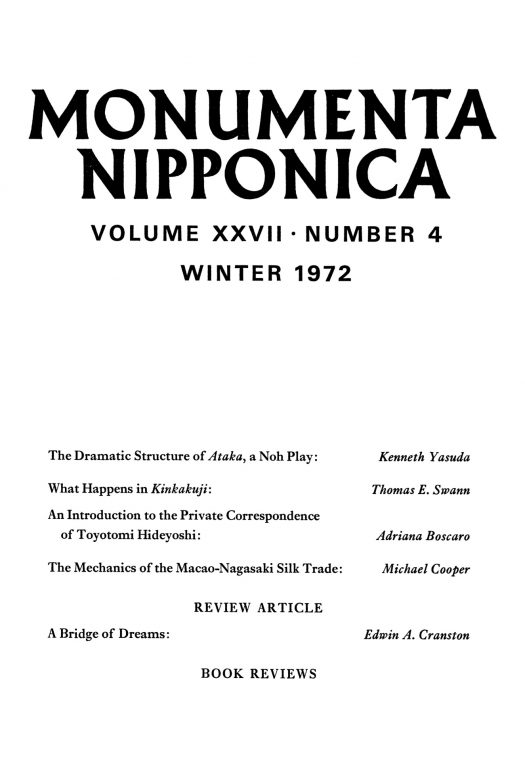 MN 27:4 (1972) 359–98The Dramatic Structure of Ataka, a Noh PlayKenneth Yasuda
MN 27:4 (1972) 359–98The Dramatic Structure of Ataka, a Noh PlayKenneth Yasuda MN 27:4 (1972) 399–414What Happens in KinkakujiThomas E. Swann
MN 27:4 (1972) 399–414What Happens in KinkakujiThomas E. Swann MN 27:4 (1972) 415–21An Introduction to the Private Correspondence of Toyotomi HideyoshiAdriana Boscaro
MN 27:4 (1972) 415–21An Introduction to the Private Correspondence of Toyotomi HideyoshiAdriana Boscaro













